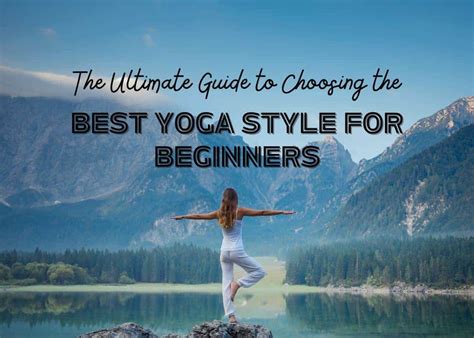Choosing the Right Yoga Style for Beginners: A Comprehensive Comparison of Popular Practices
Starting a yoga practice can be overwhelming, especially with so many styles to choose from. While yoga provides immense benefits for the mind and body, finding the right style that matches your goals, fitness level, and preferences is crucial. This article provides a thorough comparison of the most popular yoga styles for beginners, highlighting their unique aspects, benefits, and key differences to help you make an informed decision.
Introduction: The Diversity of Yoga Practices
Yoga has evolved over thousands of years and now encompasses a wide range of styles, each with distinct approaches to movement, breath, and meditation. Whether you’re looking to improve flexibility, reduce stress, or build strength, there’s a yoga style that fits your needs. This guide will break down the major types of yoga, such as Hatha, Vinyasa, Iyengar, and more, making it easier for beginners to choose a suitable practice.
Key Concepts in Yoga
- Asanas: Physical postures used to improve flexibility, strength, and balance.
- Pranayama: Breath control techniques to enhance focus and reduce stress.
- Drishti: Focal points used to maintain balance and concentration during practice.
- Bandhas: Energy locks that help control the flow of energy during certain poses.
- Chakras: Centers of energy in the body that yoga seeks to balance.
- Mantras: Sounds or words repeated for concentration and mindfulness.
Historical Context of Yoga Styles
Yoga’s roots go back over 5,000 years to ancient India, where it was practiced as a spiritual discipline. However, most modern yoga styles that are popular today, including those accessible to beginners, have been developed more recently. Hatha yoga, for example, serves as the foundation for many modern practices and has been adapted to focus on physical health as well as mental well-being.
| Style | Origins | Philosophy |
|---|---|---|
| Hatha Yoga | 15th-century India | Balance between effort and ease, emphasizes physical postures |
| Vinyasa Yoga | Modern development from Ashtanga | Flow between poses with breath |
| Iyengar Yoga | Mid-20th-century India | Precision and alignment in each pose |
| Restorative Yoga | Mid-20th-century adaptation | Relaxation and deep rest |
Current State Analysis of Popular Yoga Styles
As yoga continues to gain popularity globally, a variety of styles have emerged, each catering to different fitness goals and levels of experience. Below are the most accessible and beneficial yoga styles for beginners:
- Hatha Yoga: Focuses on slow, deliberate movements and breathing. Ideal for beginners due to its gentle pace and focus on foundational poses.
- Vinyasa Yoga: Also known as “flow” yoga, Vinyasa involves a continuous series of movements synchronized with breath. While more dynamic than Hatha, it’s beginner-friendly with modifications.
- Iyengar Yoga: Emphasizes precision and alignment, often using props like blocks and straps. Suitable for beginners looking for a methodical approach to yoga.
- Restorative Yoga: A slow, meditative practice focused on relaxation. Props support the body, making it accessible for all levels, especially those recovering from injury or stress.
- Kundalini Yoga: A spiritual style combining physical postures, breath work, and chanting. While it has a steeper learning curve, some beginners appreciate the holistic focus on energy.
- Yin Yoga: A deeply calming style where poses are held for extended periods to stretch connective tissue. Great for increasing flexibility and mindfulness.
Practical Applications of Yoga Styles
The benefits of yoga extend beyond flexibility and stress reduction. Different styles provide specific benefits that can be matched to your personal goals. Below is a guide to which styles are best suited to various outcomes:
| Goal | Recommended Style | Reason |
|---|---|---|
| Increase flexibility | Yin Yoga | Long holds in passive poses target deep connective tissue |
| Improve strength | Vinyasa or Ashtanga | Flowing sequences build muscle endurance |
| Reduce stress | Restorative or Hatha | Slow, mindful movements and breathwork induce relaxation |
| Mind-body balance | Kundalini | Focus on breath, energy, and meditation enhances mental clarity |
Case Studies: Yoga for Beginners
Let’s explore real-life examples of how different yoga styles have helped beginners meet their wellness goals:
- Susan, a 45-year-old office worker: She started with Restorative Yoga after dealing with chronic back pain and stress. After 3 months, she experienced reduced pain and improved sleep.
- John, a 28-year-old runner: John incorporated Vinyasa Yoga into his training routine to improve flexibility and reduce injury. After consistent practice, his running performance improved, and he experienced fewer injuries.
- Anna, a 35-year-old entrepreneur: Looking for balance in her busy life, Anna tried Kundalini Yoga, which helped her manage stress and develop a more grounded, spiritual approach to work-life challenges.
Stakeholder Analysis: Who Benefits from Yoga?
Yoga has a wide range of stakeholders, from individuals looking to improve personal well-being to wellness centers, gyms, and even corporate organizations promoting employee health. Let’s break down who benefits most:
- Beginners: Gain physical and mental benefits, reducing stress and improving health.
- Yoga instructors: Teaching beginner classes opens up new markets and helps spread awareness.
- Wellness centers: Attract more clients by offering a variety of beginner-friendly yoga options.
- Employers: Yoga programs at work boost employee productivity and reduce burnout.
Implementation Guidelines for Yoga Programs
If you’re planning to implement a beginner-friendly yoga program, consider the following tips:
- Offer multiple styles: Include classes like Hatha and Restorative Yoga to cater to varying needs.
- Provide beginner modifications: Ensure all classes offer accessible options for those new to yoga.
- Focus on education: Teach the fundamentals of breathwork and alignment to build confidence.
- Create a welcoming environment: Foster a non-judgmental space where beginners feel comfortable.
Ethical Considerations in Yoga Practice
Yoga has become a global wellness phenomenon, but there are ethical considerations to bear in mind, particularly around cultural appropriation, safety, and inclusivity. Here are some key points:
- Cultural respect: Yoga originates from Indian spiritual traditions. While adapting it to modern wellness needs is common, it’s essential to respect its origins and avoid commercialization that trivializes its cultural significance.
- Safety: Instructors must ensure that beginners practice safely, particularly in more dynamic styles like Vinyasa, to avoid injury.
- Inclusivity: Yoga should be accessible to all, regardless of age, body type, or ability. Classes should avoid promoting unrealistic standards of physical fitness.
Limitations and Future Research in Yoga Practices
While yoga offers extensive benefits, there are limitations and gaps in research. For example, there’s still limited scientific data on the long-term effects of yoga on specific populations, such as individuals with chronic conditions. Future research could focus on:
- Investigating the mental health benefits of various yoga styles in clinical populations.
- Understanding how yoga impacts athletic performance in different sports.
- Exploring the role of yoga in preventive healthcare, particularly in stress management and injury prevention.
Expert Commentary on Yoga Styles for Beginners
Experts agree that yoga can be transformative for beginners when they find the style that resonates most with their goals and body. According to seasoned instructors, the key to success in yoga is consistency and patience, as well as choosing a style that feels both enjoyable and manageable. Beginners are encouraged to explore different styles and modify as necessary, ensuring that their practice is sustainable over time.








